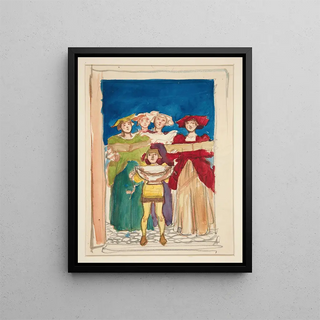Art print Croquis for Christmas card - Edwin Austin Abbey | Art print


View from behind

Frame (optional)
In the enchanting world of art, some works manage to capture the very essence of a season, evoking memories and emotions that transcend time. The "Art print for Christmas card" by Edwin Austin Abbey is one of those creations that, through its delicacy and refinement, transports us to the heart of winter festivities. This sketch, imbued with nostalgia, invites us to dive into a universe where the magic of Christmas blends with the elegance of art. Through this work, Abbey succeeds in evoking not only the spirit of the season but also an aesthetic that resonates with the traditions and values of the Victorian era.
Style and uniqueness of the work
The "Art print for Christmas card" stands out for its unique style, which combines romantic sensitivity with undeniable technical mastery. The delicate lines and meticulous details reveal a concern for realism, while also hinting at a touch of imagination. Abbey uses a palette of soft colors, evoking warmth and conviviality during the holiday season. The characters depicted, often immersed in scenes of family joy or celebration, are animated with palpable life, allowing the viewer to feel the intensity of the emotions they embody. The composition is carefully thought out, each element fitting harmoniously to create an atmosphere of serenity and shared happiness. This sketch is not just a simple illustration; it is a true hymn to the joy and love that characterize this festive period.
The artist and his influence
Edwin Austin Abbey, a prominent figure of 19th-century American art, knew how to mark his era with his distinctive style and his commitment to representing historical and literary themes. Trained both in the United States and in Europe, Abbey integrated influences from great masters while developing his own artistic voice. His work, often inspired by literature and mythology, testifies to a deep understanding of stories and human emotions. Through his works, he captured the essence of his time while anticipating future evolutions of art. The impact of Abbey

Matte finish

View from behind

Frame (optional)
In the enchanting world of art, some works manage to capture the very essence of a season, evoking memories and emotions that transcend time. The "Art print for Christmas card" by Edwin Austin Abbey is one of those creations that, through its delicacy and refinement, transports us to the heart of winter festivities. This sketch, imbued with nostalgia, invites us to dive into a universe where the magic of Christmas blends with the elegance of art. Through this work, Abbey succeeds in evoking not only the spirit of the season but also an aesthetic that resonates with the traditions and values of the Victorian era.
Style and uniqueness of the work
The "Art print for Christmas card" stands out for its unique style, which combines romantic sensitivity with undeniable technical mastery. The delicate lines and meticulous details reveal a concern for realism, while also hinting at a touch of imagination. Abbey uses a palette of soft colors, evoking warmth and conviviality during the holiday season. The characters depicted, often immersed in scenes of family joy or celebration, are animated with palpable life, allowing the viewer to feel the intensity of the emotions they embody. The composition is carefully thought out, each element fitting harmoniously to create an atmosphere of serenity and shared happiness. This sketch is not just a simple illustration; it is a true hymn to the joy and love that characterize this festive period.
The artist and his influence
Edwin Austin Abbey, a prominent figure of 19th-century American art, knew how to mark his era with his distinctive style and his commitment to representing historical and literary themes. Trained both in the United States and in Europe, Abbey integrated influences from great masters while developing his own artistic voice. His work, often inspired by literature and mythology, testifies to a deep understanding of stories and human emotions. Through his works, he captured the essence of his time while anticipating future evolutions of art. The impact of Abbey
12,34 €






